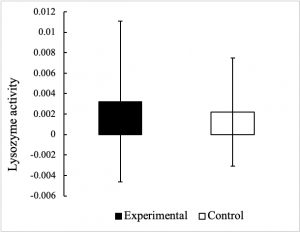6 Hot or Not?
Breanna Hartung and Neha Nagaraj
Effect of heat shocks on adult male Acheta domesticus cricket’s immune system.
Climate change… global warming… heat waves, remind you of something? I hope they do because that is what we will be addressing from here on out!
I’m sure you all have heard this topic in the news, media, or in your everyday lives, but we will address it again as it is such a serious issue today. Years of ignoring its urgency have brought us here to an alarming increase in global warming that has in turn increased the occurrence of heatwaves.
Heatwaves are a period of high-intensity heat with varying temperatures that last a couple of days depending on the location it takes place in. These heat waves can have lasting effects on not only the environment but the health of people and animals. To understand these effects, we did a study on how crickets’ immune function will be affected when exposed to a heat shock. We chose to focus on the immune function as it serves a vital role in insects’ survival and development. This is because crickets are ectothermic organisms and therefore rely more on lytic activity and behavioral mechanisms to stay healthy rather than internal processes. We specifically chose to measure cricket’s lysozyme levels after their exposure to a heatwave lasting 6 days. Since lysozyme is an enzyme that helps kill bacterial infections, measuring its’ levels helped determine how ready the crickets were for an immune challenge after exposure to a heatwave. We compared these results to that of the control group that was kept at the control environment of 28°C for the same duration. We expected to see a higher lysozyme count for those that were exposed to a heatwave, but rather, we noticed that there was no significant difference between the two groups. While this is not what we predicted, it is a good outcome as it confirms that the crickets may have had sufficient time to recover from the heat shock thus indicating that their immune system may not be their main concern as heat waves increase!
Methods
Incubation Period
We placed 50 adult male crickets from our first trial in the heat-shocked environment for 6 days. The heatwave we used mimicked a July 2019 heatwave in Indianapolis which is in the Midwest (native to A. domesticus crickets). This heatwave included an elevated temperature on the first day (31°C), followed by 4 days of extreme temperature (34°C), and returned to 31°C on the last day. The control group was housed in the incubator at 28°C for 6 days.
Lysozyme Assay
As lysozyme kills bacteria, to measure how much lysozyme was present, we mixed the crickets hemolymph with a known amount of bacteria and measured the growth curves using a spectrophotometer. If there was a high lysozyme count in the samples, we expected the bacteria to grow less quickly.
Results
Figure 1 shows us the percentage of crickets alive at the end of the 6-day incubation period for each group while figure 2 depicts the lysozyme activity of both groups.
We found that for both data collected, the results showed a statistically insignificant difference between the experimental and control group, which indicates that heat waves did not have an impact on the crickets’ immune system. We came to this conclusion after using a Z-score calculator and obtaining a z value of 1.1458 and a p-value of 0.25014 for the percentage of survivors. We used an ANOVA Single Factor analysis for the lysozyme activity and got an F value of 0.5592009 and a p-value of 0.4564491. All these values obtained points towards our data being statistically insignificant!
While this is not what we were expecting, this can still be a good thing for crickets and insects in general! These results could have been due to some research showing that warmer temperatures can be immunosuppressive to certain aspects of the ectothermic immune system. In fact, in some cases, cold can upregulate some genes in charge of immune function and consequently strengthen the immune system. Moreover, these results also show that the immune system does not have to be their main concern post-heat wave exposure as they had enough time to recover and return to preheat wave immune levels.
We can still do further tests to see if this holds true across the globe as climate change is worsening and heatwaves don’t stay the typical 6-day heatwave we mimicked. Studies have shown that heatwaves across the globe are increasing not only in duration but intensity as well. One recorded heatwave in China lasted 27 days and reached a maximum temperature of 41.1°C! While we can’t possibly test all the different types of heatwaves across the globe, varying our temperatures and duration in future trials can help determine if the effects we noticed are consistent across the board.
Additionally, further research could also include testing other facets of insect immune systems like levels of phenoloxidase. As global warming becomes more severe it is key to understand whether its impact on organisms is negative or positive. This can determine potential changes to the population and evolution of those organisms in the future. To find out more feel free to visit these research papers…
https://www-sciencedirect-com.proxyiub.uits.iu.edu/science/article/pii/S0003347201917865
https://www-sciencedirect-com.proxyiub.uits.iu.edu/science/article/pii/S0022191003002531
https://jeb-biologists-org.proxyiub.uits.iu.edu/content/214/12/1997.short


 Figure 2
Figure 2 Figure 1
Figure 1